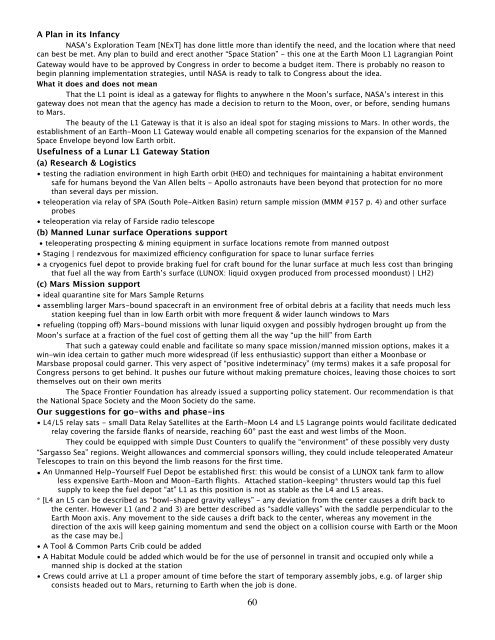Space Transportation - mmmt_transportation.pdf - Moon Society
Space Transportation - mmmt_transportation.pdf - Moon Society
Space Transportation - mmmt_transportation.pdf - Moon Society
Create successful ePaper yourself
Turn your PDF publications into a flip-book with our unique Google optimized e-Paper software.
A Plan in its Infancy<br />
NASA’s Exploration Team [NExT] has done little more than identify the need, and the location where that need<br />
can best be met. Any plan to build and erect another “<strong>Space</strong> Station” - this one at the Earth <strong>Moon</strong> L1 Lagrangian Point<br />
Gateway would have to be approved by Congress in order to become a budget item. There is probably no reason to<br />
begin planning implementation strategies, until NASA is ready to talk to Congress about the idea.<br />
What it does and does not mean<br />
That the L1 point is ideal as a gateway for flights to anywhere n the <strong>Moon</strong>’s surface, NASA’s interest in this<br />
gateway does not mean that the agency has made a decision to return to the <strong>Moon</strong>, over, or before, sending humans<br />
to Mars.<br />
The beauty of the L1 Gateway is that it is also an ideal spot for staging missions to Mars. In other words, the<br />
establishment of an Earth-<strong>Moon</strong> L1 Gateway would enable all competing scenarios for the expansion of the Manned<br />
<strong>Space</strong> Envelope beyond low Earth orbit.<br />
Usefulness of a Lunar L1 Gateway Station<br />
(a) Research & Logistics<br />
• testing the radiation environment in high Earth orbit (HEO) and techniques for maintaining a habitat environment<br />
safe for humans beyond the Van Allen belts - Apollo astronauts have been beyond that protection for no more<br />
than several days per mission.<br />
• teleoperation via relay of SPA (South Pole-Aitken Basin) return sample mission (MMM #157 p. 4) and other surface<br />
probes<br />
• teleoperation via relay of Farside radio telescope<br />
(b) Manned Lunar surface Operations support<br />
• teleoperating prospecting & mining equipment in surface locations remote from manned outpost<br />
• Staging | rendezvous for maximized efficiency configuration for space to lunar surface ferries<br />
• a cryogenics fuel depot to provide braking fuel for craft bound for the lunar surface at much less cost than bringing<br />
that fuel all the way from Earth’s surface (LUNOX: liquid oxygen produced from processed moondust) | LH2)<br />
(c) Mars Mission support<br />
• ideal quarantine site for Mars Sample Returns<br />
• assembling larger Mars-bound spacecraft in an environment free of orbital debris at a facility that needs much less<br />
station keeping fuel than in low Earth orbit with more frequent & wider launch windows to Mars<br />
• refueling (topping off) Mars-bound missions with lunar liquid oxygen and possibly hydrogen brought up from the<br />
<strong>Moon</strong>’s surface at a fraction of the fuel cost of getting them all the way “up the hill” from Earth<br />
That such a gateway could enable and facilitate so many space mission/manned mission options, makes it a<br />
win-win idea certain to gather much more widespread (if less enthusiastic) support than either a <strong>Moon</strong>base or<br />
Marsbase proposal could garner. This very aspect of “positive indeterminacy” (my terms) makes it a safe proposal for<br />
Congress persons to get behind. It pushes our future without making premature choices, leaving those choices to sort<br />
themselves out on their own merits<br />
The <strong>Space</strong> Frontier Foundation has already issued a supporting policy statement. Our recommendation is that<br />
the National <strong>Space</strong> <strong>Society</strong> and the <strong>Moon</strong> <strong>Society</strong> do the same.<br />
Our suggestions for go-withs and phase-ins<br />
• L4/L5 relay sats - small Data Relay Satellites at the Earth-<strong>Moon</strong> L4 and L5 Lagrange points would facilitate dedicated<br />
relay covering the farside flanks of nearside, reaching 60° past the east and west limbs of the <strong>Moon</strong>.<br />
They could be equipped with simple Dust Counters to qualify the “environment” of these possibly very dusty<br />
“Sargasso Sea” regions. Weight allowances and commercial sponsors willing, they could include teleoperated Amateur<br />
Telescopes to train on this beyond the limb reasons for the first time.<br />
• An Unmanned Help-Yourself Fuel Depot be established first: this would be consist of a LUNOX tank farm to allow<br />
less expensive Earth-<strong>Moon</strong> and <strong>Moon</strong>-Earth flights. Attached station-keeping* thrusters would tap this fuel<br />
supply to keep the fuel depot “at” L1 as this position is not as stable as the L4 and L5 areas.<br />
* [L4 an L5 can be described as “bowl-shaped gravity valleys” - any deviation from the center causes a drift back to<br />
the center. However L1 (and 2 and 3) are better described as “saddle valleys” with the saddle perpendicular to the<br />
Earth <strong>Moon</strong> axis. Any movement to the side causes a drift back to the center, whereas any movement in the<br />
direction of the axis will keep gaining momentum and send the object on a collision course with Earth or the <strong>Moon</strong><br />
as the case may be.]<br />
• A Tool & Common Parts Crib could be added<br />
• A Habitat Module could be added which would be for the use of personnel in transit and occupied only while a<br />
manned ship is docked at the station<br />
• Crews could arrive at L1 a proper amount of time before the start of temporary assembly jobs, e.g. of larger ship<br />
consists headed out to Mars, returning to Earth when the job is done.<br />
60















